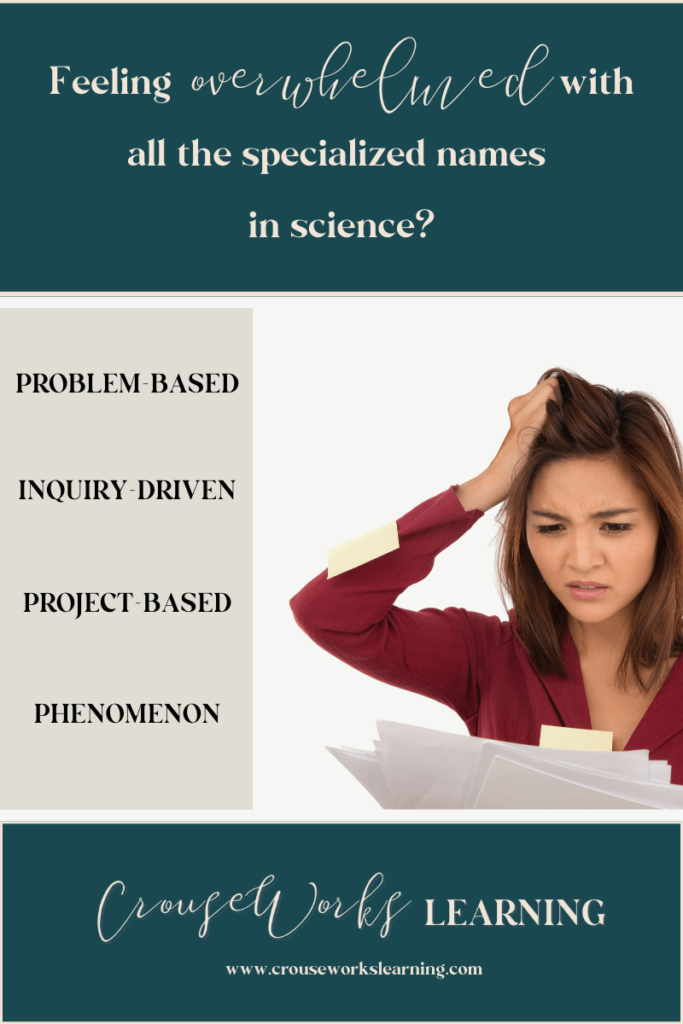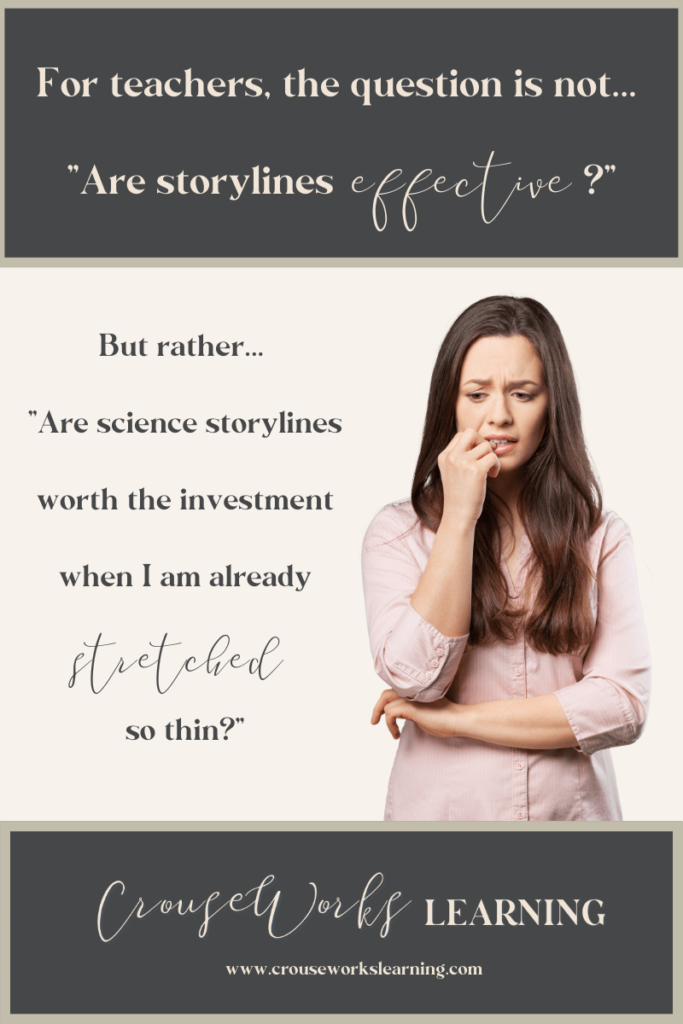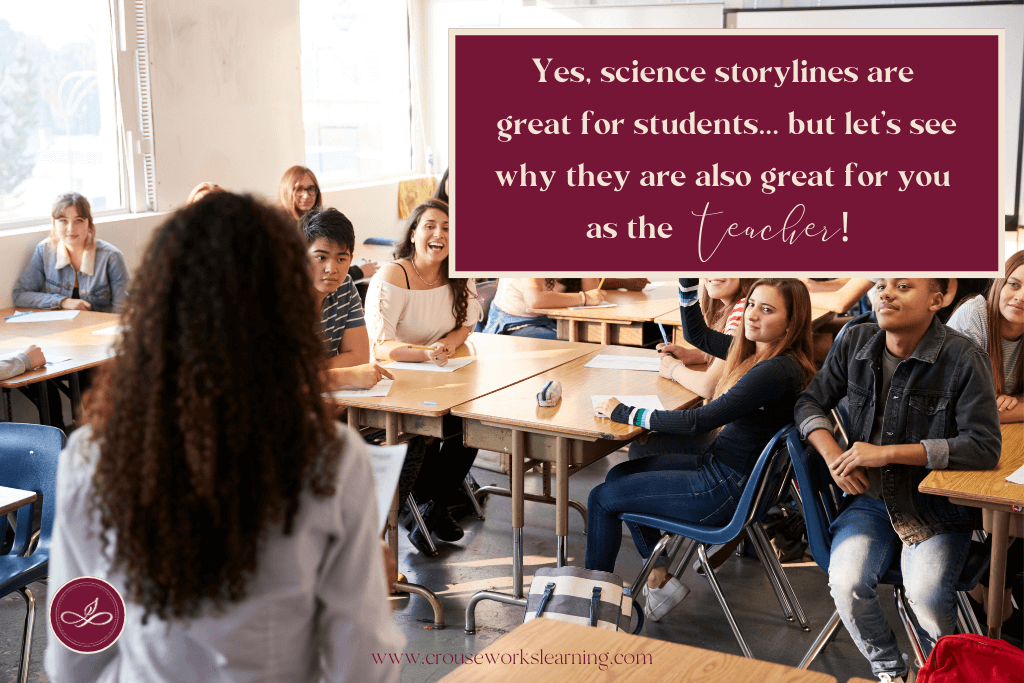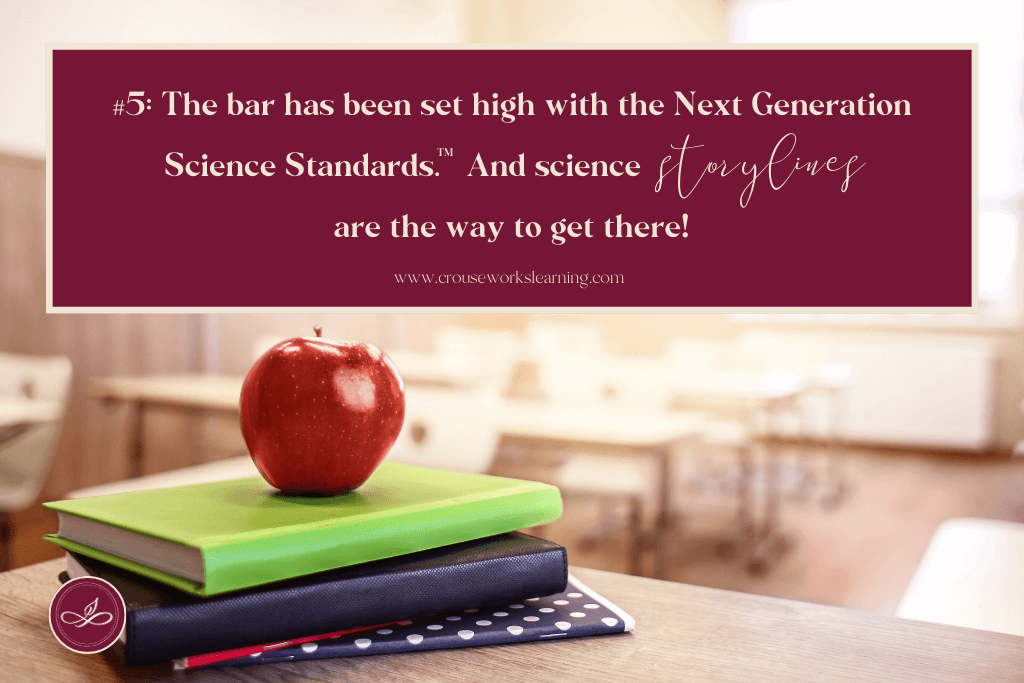Have you ever signed up for professional development on how to engage the students in your class better? And in the professional development you attended, did they mention terms like…
Project-Based Learning
Problem-Based Learning?
Phenomenon-Based Learning?
Inquiry-Based Learning?
Whew, and the list keeps going! … As you know, we are never short of specialized names in the educational space!

How are we supposed to keep track of all these learning strategies?
The good new is while these learning strategies may seem different at first, they’re actually quite similar. They all fall under the umbrella of “storyline” instruction.
If you are unfamiliar with science storylines…
NGSS defines a science storyline as…
"A science storyline is a coherent sequence of lessons in which each step is driven by students' questions that arise from their interactions with phenomena. A student's goal should always be to explain a phenomenon or solve a problem. At each step, students make progress on the classroom's questions through science and engineering practices to figure out a piece of a science idea. Each piece they figure out adds to the developing explanation, model, or designed solution. Each step may also generate questions that lead to the next step in the storyline. Together, what students figure out helps explain the unit's phenomena or solve the problems they have identified. A storyline provides a coherent path toward building the disciplinary core idea and crosscutting concepts, piece by piece, anchored in students' own questions."
Next Generation Science Standards Tweet
In other words, teachers are no longer the “gatekeepers of knowledge” in the classroom. Instead, students now drive learning through real-world connections, collaborative exploration, and high-level questioning.

Why teachers feel iffy about using storylines to engage the students in their science classes...
When I talk with teachers about ways to engage the students in class through science storylines, I often hear things like, “I like and agree with a lot of the ideas behind storylines, but I have yet to see a classroom actually implement them well…” Or I’ll hear, “I’ve tried engaging kids with fun, long-term, hands-on, real-world projects, but they lose focus and interest and can’t seem to stick with anything for very long…”
In fact, let’s be honest… when you hear the phrase “storylines,”… have any of these thoughts ever crossed your mind?
- “Storylines are nice in theory but hard to execute with all the interruptions and absences in school…”
- “When I allow students to drive their learning by asking questions like, ‘What do you feel about _____?’ or ‘What do you think would happen if _____?’ students will just shrug and leave the answers blank…”
- “We only have so much time in the classroom, and storylines take a lot of time and prep. Give me half the students or twice the time, and I might be able to do more with storylines…”
- “I’m not convinced students will put in the work. It seems like they would rather just type the whole question into Google and paste the first thing that pops up…”

So, is it worth it to invest in storylines as a way to engage the students in your science classes?
So, are science storylines worth it? In my experience, most science teachers like the theory behind storylines. They are on board with engaging students in more real-world, hands-on, inquiry-based science lessons. It’s just the implementation of those lessons that seems too out of reach…
I believe for science teachers, the real question is NOT, “Are storylines an effective way to engage the students in my classes?” But rather, “Is moving to a storyline teaching model worth investing my time and energy as a teacher when I am already stretched so thin?”
And by worth it, as a teacher, I mean…
- “Are storylines worth investing in when the instruction seems geared toward academically strong, more motivated, and continuously present students (attendance-wise)?”
- “Are storylines worth investing in when I know I would likely have to spend a lot of time adapting the lessons to accommodate my students’ diverse academic, motivational, and socio-emotional needs?”
- “Do I invest as a teacher when I know unit storylines require immense lesson creativity, enthusiasm, and energy to hold my students’ interest over a long time?”
- “Do I invest as a teacher when I don’t necessarily trust that I’ll have practical, tangible, ready-to-use handouts, activities, and PowerPoint slides to implement the lessons effectively?”
- “While I’m happy to make small modifications to a resource, do I invest as a teacher when I know I will likely have to put in a lot of time filling in the gaps (i.e., giant academic leaps) within a resource?”

Do you have concerns about using storylines to engage the students in your classroom?
If the concerns above have ever crossed your mind about the use of storylines as a way to engage the students in your class, you are not alone. Again, as a teacher myself, I see you, and I hear you. Yet, before throwing in the towel on storylines, I hope you will hear me out. And I hope you stick around to see why I believe switching to storyline teaching actually helps you (yes, YOU) even more than your students!
Yes, we all know using storylines in the science classroom is better for the engagement of students. Students will develop more skills, gain more interest in school, and cultivate better work habits. And while all that is certainly reason enough to invest in storylines in the classroom… truthfully, what I believe you need to hear most as a teacher right now is how storylines make teaching much more enjoyable and manageable for YOU!
We are always told to “put students first.” And while I wholeheartedly agree that it’s essential to prioritize students’ needs, it is also in everybody’s best interest to ensure teachers are similarly taken care of in the classroom. Yes, you heard me right… While storylines are undoubtedly helpful for engaging the students, another equally important reason is that they help you! Because you- yes, YOU- are just as important to support!
So how does implementing storylines benefit YOU as the teacher?
Read below for the 5 reasons why using science storylines is absolutely worth your investment as a teacher (even if it's intimidating at first!)

REASON #1: You will be inspired by the lessons you teach when you engage the students in science storylines
As teachers, we’ve all had moments leading students through content, wondering in the back of our minds, “Why is this important for kids to know?” Or we’ve asked ourselves at some point, “Am I just another cog in the wheel, going through the motions of teaching when I promised I would never do that?”
Conversely, we’ve all experienced the thrill of teaching a lesson we were particularly passionate about and inspired by. The enthusiasm that comes with teaching a lesson that is relevant, meaningful, and exciting for kids! We’ve all experienced those *special moments* when it’s really fun to be a teacher…
Now just think... what if you had more days like that? More days when you were passionate about your teaching, more days when your students were engaged and curious, more days seeing your students having one “aha” moment after another… wouldn’t that fill you up as a teacher?
Any curriculum that gives you more moments like that is definitely worth investing in!
REASON #2: You won't have to multitask as much when you use storylines to engage the students in your class
I know that feeling, as a teacher, of continuously mapping out every minute of your day. In a span of one 50-minute period, you have learned to single-handedly present a science lesson, set up a lab, check in with each student either academically or motivationally, answer several phone calls from the main office, provide 1-1 tutoring for students who have been absent, hand out multiple passes from counselors, run to make copies, grade papers, etc. And then you repeat that process for 5 more class periods that day for 5 days a week! You, my friend, are miraculous at multitasking!
But can I be honest with you? Do you want to continue living each day like that? Is that sustainable for you? For this job to have real longevity (and enjoyment), your students must become more independent and self-motivated in the classroom. You need to invest in a curriculum that challenges students to depend on themselves, not you. For teaching to be sustainable, you must take some responsibilities off your plate.
REASON #3: Your students will produce work that makes them (and you!) proud
As teachers, how often have we gotten to the end of a unit, given an exam, graded those exams, and then just moved on to the next unit? I don’t know about you, but I don’t feel particularly inspired when I grade exams. While I love seeing students be successful on exams, I don’t ever hold on to students’ exams as keepsakes at the end of the school year.
However, what I do get inspired by, is looking at storyline capstone projects. When students have to apply their knowledge to real-world problems and learn to communicate their solutions effectively to an audience, that is work I get inspired by!
Think about a time when you gave students a big project. And not only did students meet all the criteria for the project, but they ended up producing something that went far beyond what you assigned initially. When you see students take ownership of their work, it is inspiring! Moments like that keep you going and make you excited and grateful to be a teacher!

REASON #4: Your energy will go to more important things when you engage the students in storylines
When I bring up cell phones and bathroom passes in the classroom, what feelings does this bring up for you? Angst? Exhaustion? Frustration?
As teachers, we have all been there. The cognitive energy that goes in every day trying to sort through when to allow bathroom passes and when not to. And when to let students be on their phones and when not to.
Every day you have to make countless decisions on all that and more. That takes a lot of energy. In fact, did you know the average teacher makes 1500 decisions per day?
Now, imagine you didn’t have to make so many decisions in a day. What if you didn’t have to worry as much about cell phones and bathroom passes? Having curriculum materials that engage students and build their stamina in class will free you up to be the teacher you always wanted to be…
Because heck… none of us went into teaching desiring to pick battles with kids over cell phones and bathroom passes. Rather we got into teaching because we wanted our time and energy to go toward meaningful work!
So, imagine if there was a curriculum that engaged students with exciting content AND built up their confidence and work ethic in the classroom. How great that would be?!
How much would you give to see your students working productively in the classroom and enjoying themselves every day? Because that reality is coming for you! It’s in your grasp…
REASON #5: You will finally master those lofty NGSS standards when you use storylines to engage the students
The NGSS standards are wonderful in so many ways, but they can often feel very lofty, leaving you feeling like you need to do more for your students in class. I don’t know about you, but it took me a long time to understand the NGSS standards. How do the standards work? What is the difference between disciplinary core ideas, science and engineering practices, and crosscutting concepts? How do I practically implement these standards in my classroom? How will I know if students have achieved mastery?
The bar has been set high for us with the Next Generation Science Standards. But step-by-step guidance for how to reach the bar needs to improve. From my experience, most science teachers want to teach to the NGSS standards. Most teachers want to develop students’ skills more holistically in science. But guidance on effectively (and practically) implementing NGSS standards is still in development.
If we, as teachers, had access to a curriculum that not only broke down the standards in realistic and accessible ways but also supported students in developing the stamina, confidence, and work ethic to reach those standards- it would be a game-changer. And investing in storyline teaching is an important step forward in that direction!

To wrap up...
Switching to storyline teaching is absolutely worth your investment as a science teacher. Not only does it increase the engagement of students in class, but it also immensely helps YOU as a teacher! You will find more fulfillment, enjoyment, and sustainability in teaching when you switch to a storyline-based approach.

P.S. Want to see some examples of science storylines in chemistry and biology? Then scroll through these exciting resources below!













